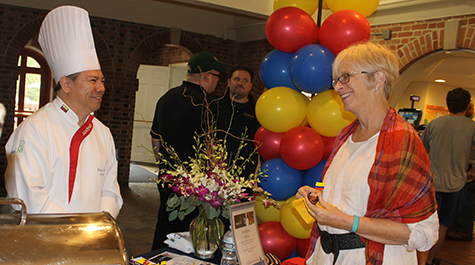Food without borders
They may not save lives in the same way as Doctors without Borders, but Sodexo’s traveling international chefs can transform lives by opening minds and palates to new ways of experiencing and preparing food.
Each year, about a dozen Sodexo chefs (representing some 80 countries) travel to college campuses across the U.S., including William & Mary, to share their cooking. As with any good cultural exchange, the impact comes from both giving and receiving. The mission of Sodexo’s Global Chef Program is for the chefs to share their authentic native cuisine and culture while also exposing them to the food and culture of the U.S. and Canada.
Sodexo’s contract with William & Mary Dining Services makes the university eligible to participate in this creative — and delicious — exchange, but not all of Sodexo’s university clients are selected to participate.
“William & Mary was chosen as a host site of the Global Chef training because of its superior culinary program and the diversity of the campus population,” said Melissa Strain, marketing manager for William & Mary Dining Services.
Every fall and spring since 2014, William & Mary has welcomed chefs from around the world. They have represented the cuisines of China, Chile, Netherlands, Ireland, Colombia, Poland, Russia, Sweden and Malaysia.
This fall, Chef Ashwin Iyangar from India brought his expertise and philosophy to campus. He is Sodexo’s project manager/food platform, and he believes in the idea of “food without borders.”
Iyangar was born into a family of hoteliers in Virar, a small town near Mumbai, and he knew from age 14 that he cooking would be his life’s work. He started working with Sodexo in May 2017.
“I was part of the Global Chef Program in India, where I would coordinate the events of the Chef who would visit. But this is my first tour as a Global Chef,” he said.
He is an ambassador for the program as much as for Indian cuisine.
“For the students, it's an exposure to authentic cuisines outside the United States, and it gives me as a Chef the opportunity to travel, to familiarize myself with different cultures and to spread the beauty of my cuisine,” he said.
His activities during his five-day stay at William & Mary took him across campus, in order to reach as many students as possible. He provided demonstrations and samples at lunchtime at the Sadler Center and Commons, and dinner at the Marketplace in Campus Center. Iyangar also shared his most important advice for creating authentic Indian cuisine: “Have as many spices as possible, and research the right blend of spices for each recipe.”
His reviews of the experience in Williamsburg were glowing.
“I really appreciated the excitement and eagerness of the students to try something new and different,” he remarked. He also had nothing but praise for the Dining Services staff: “They were one of the most helpful teams I came across during my entire tour and the most gracious hosts as well.”
A gastronomic COLL 300
The purpose of COLL 300 is to connect students with people, places and ideas that take them out of familiar surroundings and deepen the way they see themselves in the world and to introduce them to people and ideas that are outside of their sphere of direct experience.
Although the program will not get a student COLL 300 credit on their transcript, it does enhance the curriculum’s mission in a visceral and engaging way, said Strain.
“The Global Chef Program provides the William & Mary campus with the opportunity to learn and understand different communities and cultures through journeys of taste,” she explained. “Students and staff look forward to interesting culinary masterpieces and the opportunity to hear our culinarian’s story.”
Strain is as enthusiastic about the program and its possibilities for exchange of dishes and approaches as Iyangar is.
This is one of my favorite events of the year,” Strain said. “Not only do you get to eat great food, but you get to meet new, interesting people and learn about their culture and way of life. Every semester is a new culture and new adventure.”






















